|
Limestone hills and caves have virtually no protection in Malaysia. According to the USA Federal Cave Protection Act of 1988, the term "cave" means any naturally occurring void, cavity, recess, or system of interconnected passages which occurs beneath the surface of the earth or within a cliff or ledge (including any cave resource therein) and which is large enough to permit an individual to enter, whether or not the entrance is naturally formed or manmade. Such term shall include any natural pit, sinkhole, or other feature which is an extension of the entrance.
The term "cave resource" includes any material or substance occurring naturally in caves on Federal lands, such as animal life, plant life, paleontological deposits, sediments, minerals, speleogens, and speleothems.
The above relates to the US, and there are no such laws in Malaysia. Cave resources are plundered in many places. Other places in SE Asia do have cave protection. Philippines has 364 caves that are protected (2014) by The Department of Environment and Natural Resources (DENR).
Some reasons caves and limestone hills should be protected :
- they may be habitats for endangered species of flora and fauna
- they may contain raw mineral or unique land forms
- they may have hydrological importance
- they may be culturally important, both historic and prehistoric
- they may have spiritual or religious importance
- they may be important sites for the study of geology, geomorphology, palaeontology etc.
- they may be important for tourism or recreation
QUARRYING
Quarrying is a constant threat to limestone hills. There is an ever increasing demand for cement and crushed stone and clinker, and limestone hills are destroyed to satisy this demand. The limestone is also quarried for the mineral content such as dolomite. Some quarry companies have already got permission to quarry hills 90 years from now. Other hills are quarried for their marble, especially in the Kinta Valley and on Langkawi.
There is a lot of subsurface limestone, especially in the Kinta Valley area of Perak, and although subsurface quarrying is done, so far no underground mining has been carried out. The main reason is the cost. State governments have been urged by conservation bodies to preserve the limestone hills with their unique biodiversity, but most quarry companies seem more interested in short-term monetary gains. In July 2009 the Perak state government announced it will relocate quarry operations to alternative sites, far away from densely populated areas. But they would not shut down the quarries. One hill that has been completely quarried away and even subsurface limestone was removed, leaving a deep pool, is Bukit Panching in Pahang (near Bukit Charas).
The Star 3 Nov 2011 reported that 488,961 tonnes of high-grade limestone were exported in 2010. I don't know if this actually means just the good grade or the total limestone. See more figures on s 2011. And another piece calling for protection of hills on 4 Nov.
Limestone is also used to make cement as well as for the lime industry. Lime, CaO is manufactured from limestone or other sources of calcium carbonate (CaCO3) such as coral, chalk or oyster shells. Two main types of lime are produced, quicklime or unslaked lime (calcium oxide) and hydrated lime or slaked lime (calcium hydroxide). See photos of some old fashioned lime kilns in Perak.
Some hills are also quarried for their dolomite content. Dolomite is a carbonate mineral composed of calcium magnesium carbonate. The Chuping hills in Perlis were found to contain dolomite.
Many of the hills are home to endemic species of flora and fauna. There are rare mononphyllaea and begonias which are only found on certain hills. Inside the caves, some spiders are only found in one cave and no where else. In Australia in 2008 a quarry company stopped quarrying to save a rare ghost bat (IUCN red listed at Mount Etna. In USA in 2012 a $15 million highway project in San Antonio, Texas was halted after the discovery of a rare eyeless spider. Other caves contain stunning formations and may have important archaeological relics.
A good article in The Ecologist on the effects of quarrying on cave ecosystems.
Important Caves In Danger :
Gua Puncak, Gunung Lanno, Ipoh, Perak, contains Peninsular Malaysia's second largest chamber. Gua Puncak is also important historically as it was mined for tin and contains relics from the mining days, including an old railway line, tools, and a concrete dam. In April 2006 a quarry company started work outside Gua Puncak and partly blocked the small entrance. Another nearby cave was lost when its entrance was covered by rock.
It was reported in 2008 that YTL Cement Corp may be setting up a cement plant and presumably quarrying Gunung Jebak Puyuh, which is at Senyum, in Pahang. Although the hill is rather small it has around 20 known caves, some of which are quite interesting. The hill is important also for its biodiversity in flora and fauna.
In Sept 2012 I heard that some of the Merapoh hills will be quarried. We later found out the company is ASN Cement. During the caving expedition there, I spent several days with the locals looking at those particular hills. And the best cave we found, Gua Hari Malaysia, is in the area that might be quarried. Since the expedition I have returned several times to explore more Merapoh Caves, see my blog. By the end of 2013 it seemed that the area might be saved from quarrying and the cement plant. But then a new threat reared it's head in early 2014 - the area could be under threat from rare earth mining. Another problem started in 2017, illegal logging in the area, see below, under LOGGING. And it seems that ASN might be quarrying the hills at Chiku 7, north of Gua Musang in Kelantan.
In 2013 we heard that Gua Kanthan was in danger of being quarried by Lafarge. This is home to the endemic trapdoor spider, Liphistius kanthan which is on the IUCN Red List as critically endangered. The hill, Gunung Kanthan, is also home to other endangered species of flora and fauna, including a snail and a gecko. See more on the situation on the Archives 2013 and Archives 2014 and Archives 2015 and my blog which has several posts about Gua/Gunung Kanthan and the quarrying.
Bukit Sagu and Bukit Tenggek in Pahang are also being quarried, by YTL, and both hills are home to endemic flora and fauna and are archaeological sites. See more on my blog and a mention of the snails. The snail Plectostoma sciaphilum that was found on Bukit Panching which has now completely been removed by quarrying is mentioned on IUCN report.
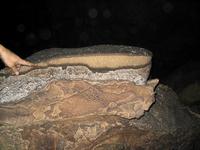
strange sediments |
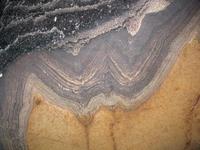
interesting layers |
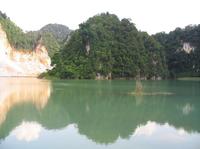
view from Gua Puncak |
CRYSTALS & SPELEOTHEMS
Another threat to caves is the removal of crystals, and to a lesser extent, speleothems. For a decade or so, people have been removing crystals from caves, particularly in Kedah and Perlis. There is a demand for crystals from crystal shops and mineral collectors. This is an increasing problem as locals see it as a way to make money and indiscriminately take crystals from caves.
Calcite crystals found in caves are formed of calcium carbonate. Calcite is one of the most common minerals on earth, yet shops seem to sell the crystals as something special. Calcite constitutes a significant part of all three major rock classification types and there are several varieties of calcite, but it is the primary mineral component in cave formations. It takes millions of years for the calcite to accumulate into formations such as stalactites and stalagmites.
Gunung Keriang in Kedah is often in the news. In 1998 the media stated how villagers were making good money by selling the cave crystals. There was a succession of articles on a similiar theme, and a local TV station showed a programme on the removal and sale of crystals. All these reports suggested that it was a good thing. In the Sunday Star, 9 March 2008, there was an article on Gunung Keriang, the writer said "Located about 12km from the city centre, Mount Keriang is a natural habitat of hundreds of species of trees and plants. It also has a limestone outcrop with attractive crystal stones waiting to be excavated." And further in the article "you will see people on the side of the cliff at the foot of the mountain. These people are busy digging for crystals. To get the crystals is not an easy job as it takes about three weeks just to dig out one stone. These crystals are brought to their respective stalls to be cleaned and then put on display for sale. When you walk outside of the recreational area you will spot a long row of shops selling various collections of crystals. You can see for yourself the many kinds, shapes and sizes of crystals. It is said that Mount Keriang is one of the famous spots that people visit just to buy crystals. The prices vary according to the sizes. Quite a number of tourists buy crystals for decoration purposes and they believe the stones are symbols of luck and fortune. "
On April 9 2008 Bernama reported that at Gunung Keriang "Development of the crystal cave costing RM5 million [US$1.5m] includes decorative lighting and a lift to transport tourists to have a closer look at crystal rocks."
This again made the news in June 2009 when Bernama did a long piece on the Keriang crystals. The article said ""Lights and a lift would be installed to enable tourists to enter the bowels of the mountain and view the crystals in their natural condition,". And some amusing comments "People who stay near Gunung Keriang believed that the crystals found there were among the world's best and are 'alive'. They believed that when proper care was given, the crystals would grow and glow particularly when shone with lights. It takes years for the crystals to grow. The keeper should spray the living crystals with clean water at least twice a week to ensure the growth of the stones". Sadly this article will only further encourage the collection of crystals from the caves at Gunung Keriang, and possibly also from caves elsewhere.
Gunung Keriang's pride and shame NST 16 Oct 2009 featured the negative side of what is happening.
A very good article about the desecration of Gunung Keriang was posted on Harikah Daily www 6 Apr 2010.
Also Malaysia Natural Heritage has detailed info on Gunung Keriang.
July 2011 it was announced in New Straits Times that the supply of crystals is almost exhausted due to over-harvesting and the caves are almost devoid of crystals now.
An article in The Star, 28 Feb 2014, Treasures from the cave features a new gallery in Penang displaying a large collection of cave crystals all bought from the northern region of peninsula Malaysia. It took over 10 years to amass the various crystals seen in the collection. Presumably the gallery owner sees nothing wrong with desecrating natural caves and ruining them for ever and destroying their beauty, then charging to see the items stolen from Mother Nature. I wrote a letter to The Star about this and it was published on 4 March 2014.
The trade in speleothems is also becoming a problem. It is happening in many countries in Asia, where cave stals are removed and sold. It ranges from small pieces being sold by a local on the road outside the cave, to international export of huge pieces. I have written about this in Speleology magazine (2006, No 8). And this problem has been discussed at international caving conferences. More and more shops are opening up selling crystals, and some also have speleothems. A new shop in Singapore was reported 9.08, selling cave artifacts
The international trade in stal again made the news in Sept 2011 when 900 bags were siezed at the airport in the Philippines. Although not related to Malaysia, I have d the story. Then in April 2016 it was proposed to ban the import and export of stal, Manila Bulletin.
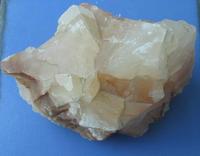
crystal from a quarry |
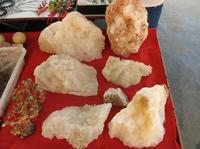
crystals for sale at Kong Fook Ngam temple |
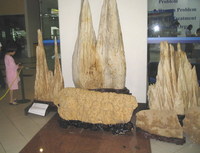
stal for sale in KL |
NO PROTECTION for ROCK PAINTINGS AND FOSSILS
Several caves have prehistoric rock paintings. Those in Painted Cave are protected under the Niah National Park. But none of the drawings in Peninsular Malaysia are protected at all, either legally or physically. Paintings are defaced by natural process, vandalism and development. The famous paintings at Gua Tambun in Perak are a prime example. The Neolithic paintings are about 2000 years old (unconfirmed). They were discovered in 1959 and first reports mention some 25-30 drawings of animals and people. The paintings are red and orange in colour, but it is not known for sure if they are made from haematite or pigments. They are actually on a rock cliff face and are exposed to the elements - bright sun, monsoon rain, wind and humidity. Although the authorities have been talking for at least 20 years, nothing has been done to protect these paintings. See news item on Tambun.
The Negrito drawings at Gua Badak, in Lenggong, Perak are also in danger. Nearby quarrying has damaged the rock face, and modern day graffiti covers some of the drawings. There are other Perak caves with paintings, also unprotected.
The rock paintings in Kelantan are slightly protected simply because there is no easy access to the caves. The same applies to caves in other states such as Pahang and Kedah.
Gua Naga Mas in Perak is a cave with the fossil of a mammal embedded in the cave wall. It was found in 1992. No real tests have been done, but the fossil is thought to be a leopard or other cat, and may date to the Pleistocene, 1.8 million to 10,000 years BP. Nothing has been done to protect this fossil see Gua Naga Mas.

Gua Tambun, the sign is new........... |
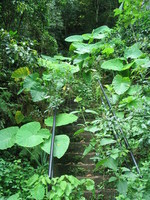
......... but the steps are overgrown (however they were cleared Dec 2008) |
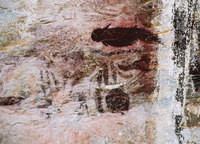
dugong or catfish at Gua Tambun |
FLORAL COLLECTIONS
The collection of plant specimens is another problem. Certain plants are indigenous to limestone, some are endangered, and none are protected under Malaysian law. Endangered plants include begonia, monophyllaea and cycads.
For several years the collection of cycads from hills in Kedah has been reported in the press. Cycads are a very primitive group of vascular plants which have survived more than 200 million years on earth. Now they are in decline and only a relict population exists. A plant can live 2500 years. They resemble palms and can grow 18m high. The fact that they are being indiscriminately collected means there is a good chance their propulation could be wiped out. In 2004, a TV documentary (Majalah 3) happily showed a man who had 35 plants valued at RM60,000 (US$16,000) at his home. He thinks nothing of cutting down trees estimated to be more than 800 years old, and will go to great lengths to obtain the cycads, even from difficult mountain tops. In 2006 the press featured a man who daily climbs a limestone hill and can collect 4-5 plants in one day. Again in June 2007 an article in the Star highlighted how cycad species are under threat, in many areas. Villagers can make up to RM1500 (US$435) per plant.
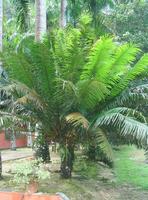
cycad in Perak |
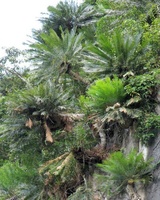
cycads high on a cliff (photo by Jan S) |
LOGGING
Logging, whether legal or illegal, around limestone hills can have an effect on the flora and fauna, and change the local climatic conditions, water flow etc. It can also mean that muddy water and debris is washed into river caves. This is now happening to caves in the Merapoh area, particularly Gua Hari Malaysia. Read more on Archives 2017. This area is also mentioned above under QUARRYING.
WATER REMOVAL
Although not yet a threat in Malaysia, it is a possible one in the future. Excessive removal of groundwater for agriculture, mining, industrial or residential use could be a big threat. In 2006 in Perak the authorities announced they want to consider mining underground water, and have identified an area to produce about one billion gallons of water daily, to supply water to the Klang Valley. Then in Aug 2007 they announced "Malaysia has found a huge underground water cave the size of Singapore". Presumably this is in fact just aquifers, and in a non karst area of south Perak around Batang Padang. In Aug 2009 the media again reported on this, saying that Batang Padang area is a good choice (this is between Slim River and Trolak) as it "enjoys a high annual rainfall of almost 3,300mm and contains favourable natural fracture and fault lines as well as large areas of undeveloped land and water catchment areas" (Star Business 26 Aug). However the Sime Derby www reports on 5 February 2009 that "a total of 105 wells have been drilled in Cluny Estate with the biggest well capable of producing 5.5 Mld of water. Each well is between 100 m and 300 m deep. Wells of such depths serve to ensure that vegetation and the ground stability of the area remain unaffected. Wells which are less than 100 m deep may not be as sustainable and there may be questions of vegetation loss and ground instability. This pilot well field in the Cluny/Bedford estate area will have its own water treatment plant from where the water will be transferred to a reservoir in Southern Perak before being distributed across the state".
Interesting piece about limestone caves and groundwater in Australia, Nov 2013.
CONTAMINANTS
In some countries there may be a threat of contaminants that infiltrate caves. These pollutants may include contaminants such as PCBs, pesticides, dioxins, gasoline, fertilizers and sewage. These can leach into caves from the surface groundwater. These may damage the fragile underground environment.
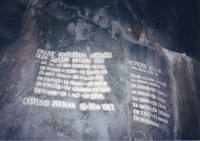
Kota Gelanggi (Muzium Negara) |
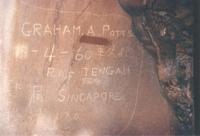
Gua Tempurung |
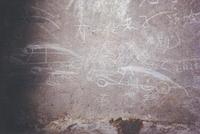
Gua Tempurung |
ROCK FALLS
Not necessarily a threat to the hill, but a threat to people in the vicinity of rock faces. Limestone cliffs have long been used by people as places of shelter. People build houses and work sites right against cliffs, seemingly oblivious of the danger of rock falls, especially on hills that have been quarried. There have been a few limestone related rock falls and landslides :
Gunung Cheroh, Perak, 1973, rock fall on squatters, 27 killed.
Gunung Tunggul, Perak, 1987, part of the hill collapsed onto a plant nursery.
Gunung Bercham, Perak, 2004, rock fall on soya bean skin factory, 2 died.
Perak Tong, 2009, rockfall in the cave temple killed the caretaker.
VISITOR NUMBERS
Large numbers of visitors can damage caves. Especially fragile caves, such as those with delicate formations or with vulnerable cave fauna. In Malaysia it is common for large numbers of people to be in one group, with few guides to watch them. One area under threat from this is Merapoh in Pahang. Large groups of people are being taken into the caves, and nothing has been done to protect the formations. There are no marked walkways and visitors are allowed to walk anywhere. See one report in Archives 2014.
GRAFFITI
Not exactly a threat, but it is an eyesore. And in some places, modern graffiti has been written over "historical" graffiti. Of course there is no clear cut distinction between modern and historial graffiti. The above 3 examples could possibly be considered historical - Muzium Negara (National Museum) expedition, and 2 from Gua Tempurung, the cars being drawn by the Communists during the Emergency War (1950's). The following 2 from Dark Cave also show Chinese and Communist writings.
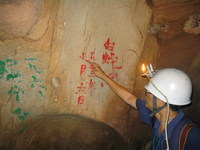
Dark Cave - White Snake Cave written in Chinese |
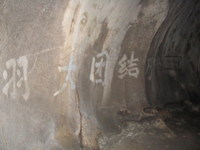
Dark Cave communist party slogan |
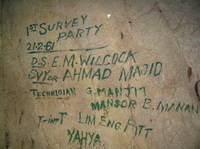
Dark Cave - history or graffiti? |
Modern graffiti
On 21 Jan 2010 it was reported in The Star that vandals had defaced Niah Cave by leaving graffiti on the walls and rocks in the Great Cave. They had even left obscene drawings. A second report followed on 26 Jan. The story is also on s 2010.
On 31 Dec 2013 there was a disturbing piece in the Borneo Post about Gua Raya in Sarawak, where it is hoped to make money by letting visitors write on rocks. I have posted the article on Archives 2013.
The following photos show some modern graffiti.
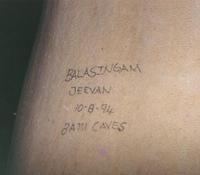
Dark Cave |
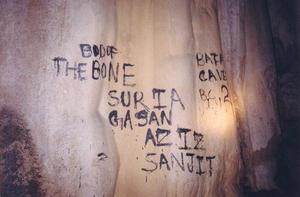
Dark Cave 1995 |
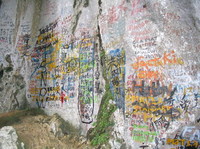
Gua Musang |

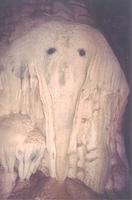
Kota Gelanggi |
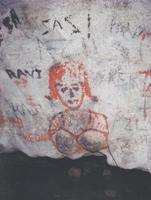
cave in Pahang 1997 |
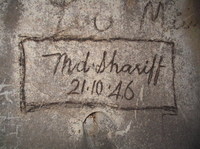
date of birth or date of graffiti?
© Liz Price 2005-2017
Last update Oct 2017 |
|
























